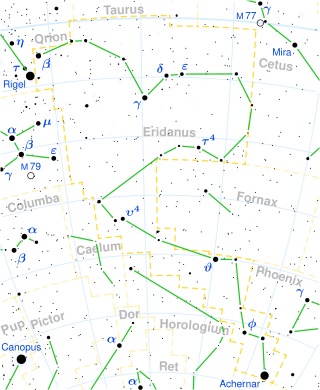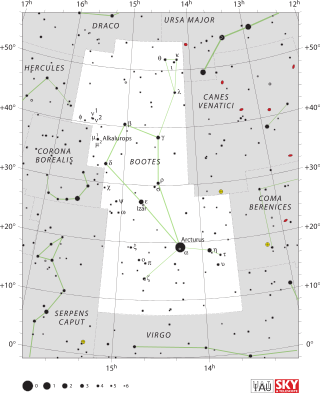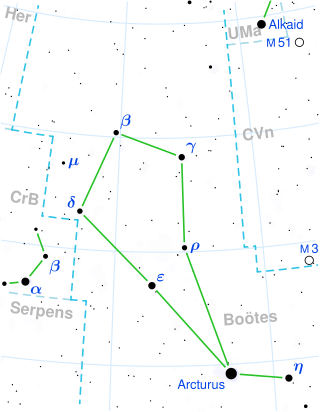
Alpha Herculis, also designated Rasalgethi and 64 Herculis, is a multiple star system in the constellation of Hercules. Appearing as a single point of light to the naked eye, it is resolvable into a number of components through a telescope. It has a combined apparent magnitude of 3.08, although the brightest component is variable in brightness. Based on parallax measurements obtained during the Hipparcos mission, it is approximately 360 light-years (110 parsecs) distant from the Sun. It is also close to another bright star Rasalhague in the vicinity.

Saiph, designation Kappa Orionis and 53 Orionis, is a blue supergiant star and the sixth-brightest star in the constellation of Orion. Of the four bright stars that compose Orion's main quadrangle, it is the star at the south-eastern corner. A northern-hemisphere observer facing south would see it at the lower left of Orion, and a southern-hemisphere observer facing north would see it at the upper right. Parallax measurements yield an estimated distance of 650 light-years from the Sun. It is smaller, less luminous but hotter at its surface than Rigel with an apparent visual magnitude of 2.1. The luminosity of this star changes slightly, varying by 0.04 magnitudes.

Castor is the second-brightest object in the zodiac constellation of Gemini. It has the Bayer designation α Geminorum, which is Latinised to Alpha Geminorum and abbreviated Alpha Gem or α Gem. With an apparent visual magnitude of 1.58, it is one of the brightest stars in the night sky. Castor appears singular to the naked eye, but it is actually a sextuple star system organized into three binary pairs. Although it is the 'α' (alpha) member of the constellation, it is half a magnitude fainter than 'β' (beta) Geminorum, Pollux.

Epsilon Sagittarii, formally named Kaus Australis, is a binary star system in the southern zodiac constellation of Sagittarius. The apparent visual magnitude of +1.85 makes it the brightest object in Sagittarius. Based upon parallax measurements, this star is around 143 light-years from the Sun.

Epsilon Pegasi, formally named Enif, is the brightest star in the northern constellation of Pegasus.

Gamma Virginis, officially named Porrima, is a binary star system in the constellation of Virgo. It consists of two almost identical main sequence stars at a distance of about 38 light-years.

Lambda Sagittarii, formally named Kaus Borealis, is a star in the southern constellation of Sagittarius. The star marks the top of the Archer's bow.

Theta Eridani, Latinized from θ Eridani, is a binary system in the constellation of Eridanus with a combined apparent magnitude of 2.88. Its two components are designated θ1 Eridani, formally named Acamar, and θ2 Eridani. The system's distance from the Sun based on parallax measurements is approximately 165 light-years.

Beta Aquarii is a single yellow supergiant star in the constellation of Aquarius. It has the official name Sadalsuud and the Bayer designation β Aquarii, abbreviated Beta Aqr or β Aqr. Based upon parallax measurements obtained during the Hipparcos mission, this component is located at a distance of approximately 540 light years (165 parsecs) from the Sun. It is drifting further away with a radial velocity of 6.5 km/s. The star serves as an IAU radial velocity standard.

Epsilon Aquarii, Latinized from ε Aquarii, is a binary star in the equatorial zodiac constellation of Aquarius, located near the western constellation border with Capricornus. It has the proper name Albali, now formally recognized by the IAU. It is visible to the naked eye with an apparent visual magnitude of 3.77, and has an absolute magnitude of −0.46. Based upon parallax measurements taken by the Gaia spacecraft, it is located at a distance of approximately 244 light-years (75 pc) from Earth. The star is drifting closer with a radial velocity of −20 km/s.

Alpha Crateris, officially named Alkes, is a star in the constellation of Crater. It is a cool giant star about 43.2 parsecs (141 ly) away.

Epsilon Cancri is a white-hued binary star system in the zodiac constellation of Cancer. It is the brightest member of the Beehive Cluster with an apparent visual magnitude of +6.29, which is near the lower limit of visibility with the naked eye. The annual parallax shift of 5.4 mas as seen from Earth yields a distance estimate of approximately 606 light-years from the Sun.

Iota Andromedae is a single star in the northern constellation of Andromeda. It has the Flamsteed designation 17 Andromedae, while Iota Andromedae is the Bayer designation as Latinized from ι Andromedae. This object is visible to the naked eye at night as a faint, blue-white hued star with an apparent visual magnitude of +4.29. Based upon parallax measurements, it is located approximately 500 light years distant from the Sun.

Gamma Boötis, Latinised from γ Boötis, is a binary star system in the northern constellation of Boötes the herdsman, forming the left shoulder of this asterism. The primary component has the proper name Seginus, the traditional name of the Gamma Bootis system. It has a white hue and is visible to the naked eye with a typical apparent visual magnitude of +3.03. Based on parallax measurements obtained during the Hipparcos mission, it is located at a distance of approximately 85 light-years from the Sun, but is drifting closer with a radial velocity of −32 km/s.

Eta Boötis is a binary star in the constellation of Boötes. Based on parallax measurements obtained during the Hipparcos mission, it is approximately 37 light-years distant from the Sun. Since 1943, the spectrum of this star has served as one of the stable anchor points by which other stars are classified. It forms a double star with the star BD+19 2726.
Mu Boötis, Latinized from μ Boötis, consists of a pair of double stars in the northern constellation of Boötes, 120 light-years from the Sun.
38 Boötis is a single star in the northern constellation of Boötes, located approximately 157 light years from the Sun. It has the traditional name Merga and the Bayer designation h Boötis; 38 Boötis is the star's Flamsteed designation. This object is visible to the naked eye as a dim, yellow-white hued star with an apparent visual magnitude of 5.76. It is moving closer to the Earth with a heliocentric radial velocity of −4.5 km/s.

Omicron2 Canis Majoris is a star in the constellation Canis Major. Since 1943, the spectrum of this star has served as one of the stable anchor points by which other stars are classified. It has an apparent visual magnitude of 3.043, making it one of the brighter members of the constellation. Based upon a distance modulus of 10.2, it is about 3,600 light-years from Earth.

Epsilon Delphini, officially named Aldulfin, is a solitary, blue-white hued star in the northern constellation of Delphinus. It is visible to the naked eye with an apparent visual magnitude of 4.03. Based upon an annual parallax shift of 9.87 mas as seen from the Earth, the system is located about 330 light-years from the Sun. At Epsilon Delphini's distance, the visual magnitude is diminished by an extinction factor of 0.11 due to interstellar dust. The star is moving closer to the Sun with a radial velocity of −19 km/s.
Theta Ceti, Latinized from θ Ceti, is a solitary, orange-hued star in the equatorial constellation of Cetus. It is visible to the naked eye with an apparent visual magnitude of 3.60. Based upon an annual parallax shift of 20m04 mas as seen from Earth, it is located about 113 light-years from the Sun. At that distance, the visual magnitude is diminished by an extinction factor of 0.28 due to interstellar dust.


















